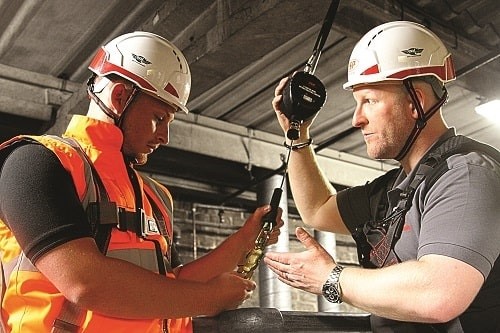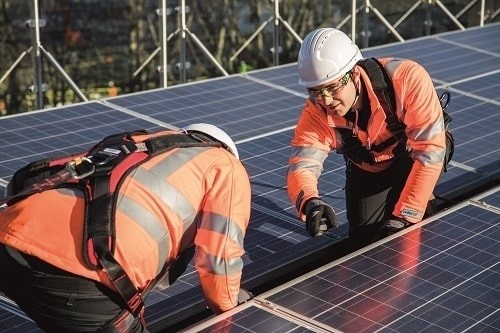Falls from height are one of the major causes of deaths in the workplace worldwide. It is therefore imperative to understand the different types of fall protection equipment options that can safely be used.
Features
Reaching new heights
Not all work at height fall protection equipment can achieve all tasks as certain equipment may have limitations.
The first step should always be fall prevention, but if fall prevention is not a possibility, then keeping employees safe by selecting fall protection equipment that can reduce the possibility and severity of falls must be a key objective for all work at height job planning.
The main thing to keep in mind when thinking of working at height is if there is a possibility of a fall, steps need to be put into place to ensure the job can be carried out safely. This can be achieved by conducting a risk assessment of the task prior to doing the job.
Types of equipment available
There is a large array of roles that are conducted while working at height. Equally, there is a multitude of fall protection equipment on the market.
- Harnesses and lanyards are a common option that come in several sizes for both men and women
- If using a harness that is designed for working at height, then we should look at which type of lanyard would be appropriate to the task, thinking of the type, size, length and work applications and may be classed as basic, intermediate or professional/technical.
Training
Working at height in the UK is governed by the Work at Height Regulations 2005 (WAHR) – this states that those involved in work at height need to be competent. Part of competence is training. It is both sensible and a legal requirement.
In the training, one should discuss the fall protection equipment and its intended use. It should also show steps to conduct pre-and post-use checks, how to do up a harness correctly as well as how to attach the lanyard. It should also mention storage and maintenance requirements of the fall protection equipment.
The training should provide basic knowledge about selecting the equipment for the application of the task.
 Part of competence is training
Part of competence is training
Types of application and standards
Understanding what type of working at height task/job is to be conducted and what it involves is imperative. For example, will it be work restraint? (Work restraint is a system of preventing the operator accessing the area that they could fall.)
Different standards are in place to ensure that the correct equipment is used and also to ensure that the equipment is fit for use as it has met a certain requirement to gain that standard.
In the UK, all equipment must meet the European standards that would be labelled on the equipment with an EN number and a CE mark.
More complex harness use may use certain work restraint equipment that meets a different standard. For example, work positioning and rope access work equipment may have additional standards.
A full body harness must comply with EN361:2002 as the general minimum requirement. Harnesses can comply with additional standards depending on the requirement and task/job, for example, EN358, EN813, EN1497.
Types of harness
The EN361 harness is the most common safety harness and is widely used on a number of different tasks/jobs.
Harnesses may come in the form of 1, 2, 3 or 5-point. A 3-point harness is generally used for work positioning work and a 5-point harness is used for working in suspension/industrial abseiling.
Lanyards
Numerous lanyards are available in work restraint, work positioning and fall arrest.
The type of lanyard must be chosen depending on the intended use. Lanyards may have single, double, fixed, tie back or adjustable points with different connection points; for example screw gate connectors (karabiners), snap hooks, scaffold hooks or tower hooks.
 A 3-point harness is generally used for work positioning work
A 3-point harness is generally used for work positioning work
Fitting
Harnesses have to be fitted correctly. If a harness is not fitted correctly, it can be extremely dangerous for the user and could result in a serious injury or possibly be fatal.
Lanyards must be used on the correct attachment on a harness as it is designed to be used.
Getting it right
If you are ever unsure about the equipment selected, speak to the provider of the equipment or look at the product instruction manual. You may also wish to request additional training.
My choice of product
I have selected a product which I feel was often in my kit when on-site as a user. The product selected is a 2M Lightweight Retractable Fall Limiter. This is a great product as it is lightweight, and the retractable lanyard moves with the user. This means there is no need to adjust the lanyard. It also meets the fall arrest standard EN360.
Unlike other EN360 lanyards you require a smaller fall clearance area as the lanyard will lock almost instantly in the event of a fall.
It has a shock absorbing pack which will deploy in the event of a fall. This keeps the impact force below 6KN.
This product is sharp-edge tested, which gives you additional confidence and it is tested to a fall factor 2.
Our fall arrest block has a user weight limit of 140 kg. It one of my favourite pieces of kit because of the above reasons. In addition, it could be used across a number of different tasks/jobs as it is lightweight and does not feel like a big piece of kit on your harness. With the retractable lanyard, it doesn’t get in your way when moving around site unlike some webbing or rope fall arrest lanyards.
My choice of basic work at height course
Specifically designed for those tasked with working at height where the elected control measure will be fall restraint, fall arrest or work positioning. This course covers relevant regulations, legislation, best practice and helps identify the safest and most suitable work methods. By also highlighting fall statistics and case studies to raise awareness it offers a comprehensive introduction to general height safety. The course is also beneficial to managers/supervisors/health and safety advisors who wish to increase their knowledge of the equipment that their workforce uses.
Inspection of personal fall protection equipment course
This course provides the required knowledge and practical hands-on experience to those tasked with conducting three or six monthly recorded inspections of items such as harnesses, lanyards and fall arresters. In addition to the essential fault-finding process, the course also covers relevant regulations, legislation, standards, completion and management of the associated inspection records.
For more information, go to: jspgo.com
Lloyd McConkey is Height safety training manager at JSP
FEATURES

Sedentary working and how to combat the ‘sitting disease’
By Gavin Bradley, Active Working on 05 April 2024
Prolonged and excessive sitting poses a major risk to our health, but the Get Britain Standing campaign and On Your Feet Britain Day on 25 April are a great way of encouraging workers to sit less and move more.

Company culture and wellbeing: a crucial link
By Bex Moorhouse, Invigorate Spaces on 05 April 2024
Investing in measures to support worker wellbeing will be ineffective unless the company culture genuinely incorporates values like teamwork, involvement, flexibility and innovation.

Office design and culture: happier and healthier staff – or the opposite?
By Guy Osmond, Osmond Ergonomics on 03 April 2024
Applying ergonomic principles to workstation set-ups and ensuring the physical environment supports neurodivergent people are just some of the ways of creating an office where everyone can thrive, but a supportive and positive organisational culture is vital too.


